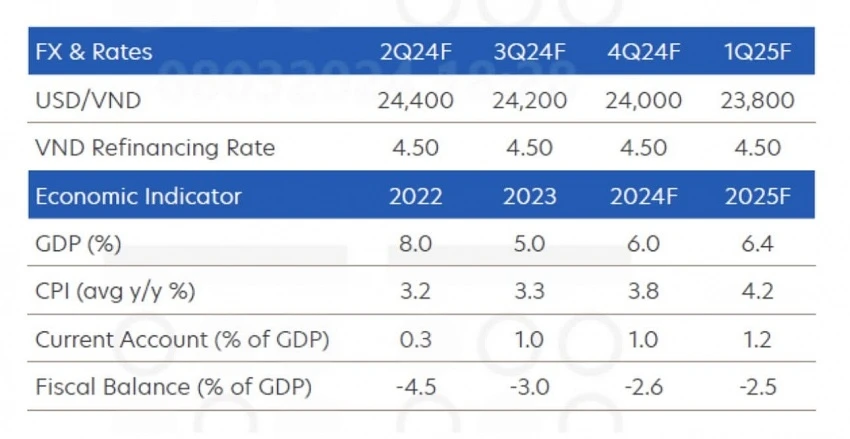
UOB released a report on March 11 outlining recovery momentum in 2024 in which it maintains a growth forecast for Vietnam at 6 per cent for 2024, which is within the official 6-6.5 per cent target. For the first quarter of 2024, UOB expects GDP growth to ease to 5.5 per cent on year due to the Lunar New Year holiday effect (higher than the 3.3 per cent in the first quarter of 2023).
Recovery of industrial production
While risks of external events continue to weigh on global economic prospects (including conflicts in Eastern Europe and the Middle East), Vietnam’s prospects are bolstered by the recovery in the semiconductor cycle, stable growth in China and the region, as well as supply chain shifts that favour Vietnam and ASEAN, the report explained.
The combined data for Jan-Feb 2024 suggest that the recovery momentum is largely on track. According to the General Statistics Office, Vietnam’s exports and industrial production in Feb fell sharply. Exports fell 5 per cent on-year, and industrial production contracted by 6.8 per cent on-year, compared to 42 per cent and 18.3 per cent expansions, respectively, in January.
The steep declines are largely attributed to the Lunar New Year/ Tet holidays in February this year which took place in January last year. For a more meaningful comparison, the combined Jan-Feb data showed that exports rose 17.6 per cent on-year, while industrial production gained 5.7 per cent compared to the average of -2.2 per cent in Jan-Feb 2023.
Vietnam’s purchasing managers’ index (PMI) showed that both January and February 2024 prints were above 50, compared to the average 49.3 reading in Jan-Feb 2023.
This data suggests that the overall momentum in the external trade and manufacturing sectors is showing positive signs and UOB expects the pace to sustain, especially in the second half of 2024 when the recovery in the semiconductor sector is more entrenched and global central banks embark on a more accommodative policy stance.
VND likely to recover modestly
SBV responded swiftly to the economic slowdown early last year with a rapid succession of interest rate cuts. The last policy rate reduction took place in Jun 2023, when it lowered the refinancing rate by a cumulative 150 base points to 4.5 per cent. With the pace of economic activities on the mend, the possibility of further rate cuts has diminished. As such, UOB believes SBV will keep the refinancing rate at the current level of 4.5 per cent.
Instead of further lowering interest rates, which are constrained by the lower bound, the government has turned its focus to non-interest rate measures to support the economy. One area is channelling credit to borrowers (quantitative measures).
In 2023, bank lending rose about 13.5 per cent on-year, marginally short of the 14-15 per cent target set for the year, as the regulator told banks to simplify lending procedures and improve businesses’ access to loans. For 2024, SBV aims to boost loan growth to about 15 per cent with the flexibility to adjust based on economic developments throughout the year.
USD/VND traded up to a new high of 24,700 in late February alongside broad USD strength against Asian peers. Despite the near-term weakness in the VND, expectations of stronger GDP growth in Vietnam (2024’s forecast of 6 per cent compared to 5.05 per cent last year) and recovery momentum in the external trade and manufacturing sectors are positive factors that may help to stabilise the VND, UOB reported.
A subsequent recovery in China's CNY – which the VND tracks – together with renewed USD weakness ahead of the Fed rate cut in June will bring forth a modest VND recovery. UOB's updated USD/VND forecasts are 24,400 in Q2, 24,200 in Q3, 24,000 in Q4 and 23,800 in Q1/2025.
In 2024, UOB anticipates inflationary pressures to remain on the upside, with a forecast of the headline CPI to stay elevated at 3.8 per cent in 2024, from 3.25 per cent in 2023.




















